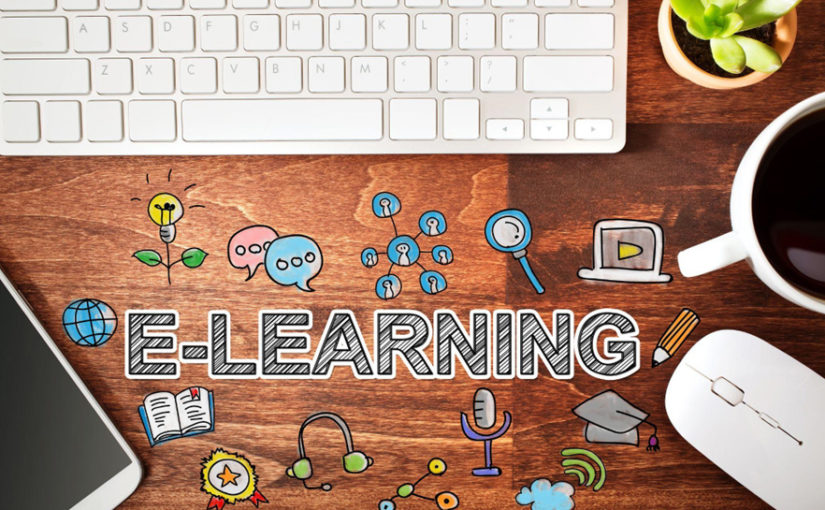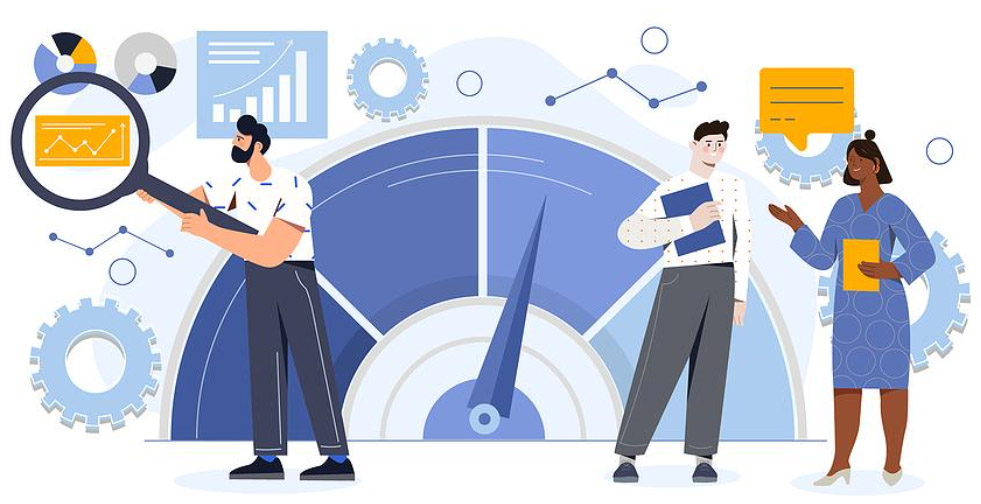
The objective of learning is not learning, it’s performance improvement. Rather than learning for the sake of it, learning should have an end product to reach that is more than than just increased knowledge.
The learning that you provide for your people, both formal and informal, should be closely linked to business outcomes and objectives. We see so many learning and development (L&D) departments put on a suite of courses or offer the latest and greatest LMS packed full of content that all lead down the same rabbit hole and contributes to no significant changes in performance.
Without viewing learning as a means to improve performance, your workplace may your training doesn’t work and you run the risk of your training budget being cut. Without performance improvements to back up your training, L&D will be seen as a cost rather than an investment.
What can be done to bridge the gap between learning and improving performance?
The answer to this is the transfer of learning. In this guide, we look at what this is and discuss ways to achieve this.

What is meant by the Transfer of Learning?
Learning transfer is what you do with your newfound knowledge or skills to improve your performance. It’s all about how to encourage, promote and evaluate the transfer of knowledge, skills, and behaviours from training to the workplace.
We’ve all been guilty of reading a self-development book and then doing absolutely nothing with all this new “wisdom” and learning we now have. We’re not transferring this learning into our work to improve the performance of what we’re doing.
We’ve been on that course (this is an example of formal learning) that required us to take multiple days out of our work schedule but then done nothing off the back of it.
We’ve all been guilty of seeing a colleague perform well at work (this is an example of informal learning) and saying to ourselves that we’re going to use a similar strategy in the future, but again it’s forgotten by lunchtime.
This frequent occurrence is a major concern for learning and development departments around the world.
The transfer of learning sparks varying debates on how much learning should be applied in the workplace for it to be classed as effective and how learning transfer should be measured.
For example, how much learning transfer is enough and is it the quantity or the outcome that is important?
Skillshub ran a leadership programme for a company where one manager negotiated a contract of materials down by £250,000 and could pinpoint the exact technique they implemented from the negotiation resources they learned from our programme. Despite this, they freely admitted that they did not implement as much of the learning as they should have.
Conversely, there were scores of managers who made small, incremental changes that impacted morale, confidence, time savings, revenue generation, reductions in health and safety incidents, and lower staff attrition. This goes to show that although big headlines like the £250,000 are one way to show learning transfer, small yet incremental business outcomes are also important for it to be measured.
We hear all the time of L&D managers quoting arbitrary figures that 60% or 80% of the learning needs to be embedded into the workplace. However, if this isn’t enforced and employees aren’t given the time, resources, and support to enable them to use their learning in the workplace, it would be unjust and unhelpful to expect those kind of results. Not only that, but some people are so overworked with daily tasks, emails, and responsibilities that they never have the time or energy to implement what they have learned.
For professional learning and development managers, measuring the transfer of learning should all be about business outcomes.

What are the Benefits of Learning Transfer?
If learning is effectively transferred into the workplace and used, there are lots of potential benefits to be had:
- Improved productivity
- Higher staff engagement rates
- Reduced staff attrition
- Improved customer service
- Higher revenues and profits
- Reduced costs
- Increased morale
- Better motivation
- Increased confidence levels
All the above are generic improvements, however if you have identified your team’s training needs and designed training to target these areas, there will be many additional positive business outcomes that are unique to your organisation too.
For example, we worked with a railway company and a couple of their unique business outcomes included:
- Reduced number of accidents on their platforms
- Reduced number of fatalities
- Reduced number of H&S incidents at their stations
- Gold standard for Investors in People accreditation
When figuring out what learning and development activities you offer, you should really start with the benefits in mind and the business outcomes you want to achieve and work backwards from there rather than the other way around.
Your business outcomes will include generic benefits like improved productivity, as well as niche benefits and your training solutions will need to reflect these objectives and ultimately provide the knowledge, skills and behaviours that will contribute to achieving the outcomes you desire.

How can you measure the Transfer of Learning?
Which of your learning events and resources have the biggest impact on your business?
Can you answer that question with real, tangible evidence?
Do you know what type of training gives you the best results? Is it face-to-face, eLearning, coaching or online resources?
These are the type of questions that you need hard and fast answers to if your L&D efforts are going to make a big impact on your organisation. The only way you are going to achieve this is by measuring the effectiveness and impact that your learning initiatives have on the business.
We always recommend that you use a proven and tested methodology. There are a few out there but let’s look at some of the most common approaches.
The Kirkpatrick Model
This is probably the most famous and common approach for measuring the transfer of learning and development.
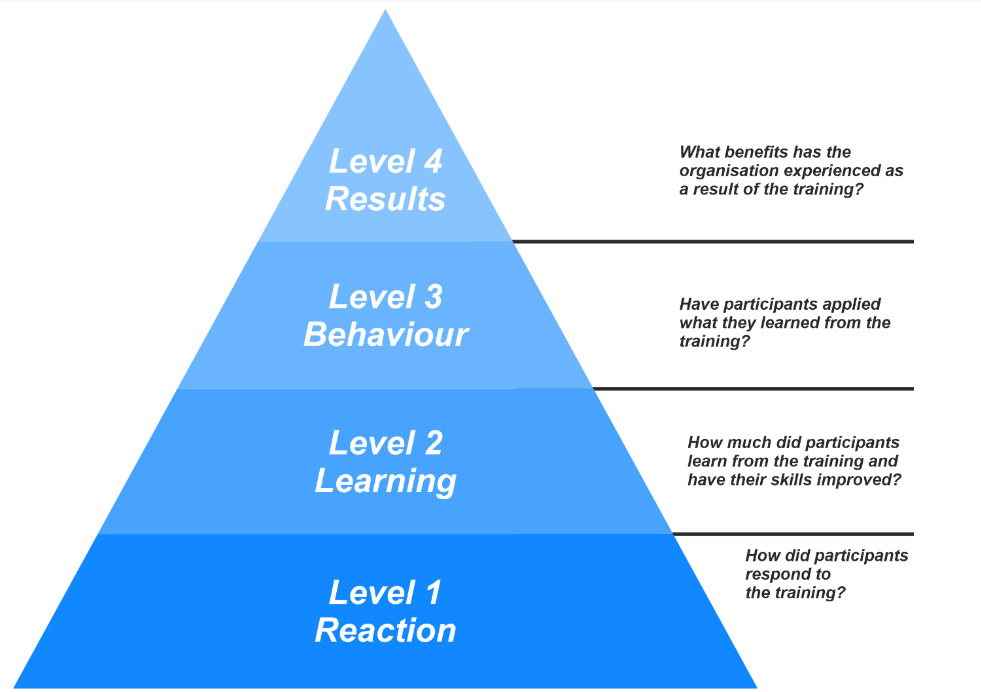
The Kirkpatrick Model has four levels of evaluation:
- Level 1 – Reaction
- Level 2 – Learning
- Level 3 – Behaviour
- Level 4 – Results

Reaction
If you use happy sheets or feedback forms at the end of an event, then you’re most likely measuring your learner’s reaction to it.
You’re evaluating how well they responded to the learning.
For example, questions could include:
- Was the content relevant?
- Was the facilitator engaging?
- Was it pitched at the right level?
- Was it delivered at the right pace?
- What was the most valuable takeaway?
- How was the training room?
- How would you rate the quality of the eLearning?
All these questions focus on an initial reaction to the learning.

Learning
Level 2 is focused on whether learning took place and how much was learnt.
Typical activities could include an assessment, test, or quiz. Some level 2 evaluations include a task of some kind to demonstrate and provide evidence of learning.
Other popular methods include self-assessment, line manager and peer feedback. Interviews, role-play, and observations are also common.

Behaviour
Have the learners shown a positive transfer of learning and applied their new knowledge and skills? This is the question that aims to be answered at level 3.
Are they using the learning positively and making changes at work?
To evidence this here are some examples of what could be used:
- 360 and 180-degree feedback
- Self-reflection and peer-assessments
- Observations
- Skills and competency interviews
One of the most widely used activities for this level is a feedback assessment where staff, peer, line managers, suppliers, customers, and the like can provide input and comments into what has changed because of the training.

Results
This level is all about whether the learning resulted in the business outcomes and benefits that it set out to achieve.
You’ll need access to data pre and post-learning and be able to link any changes to the training.
For example, if there was an uptick in sales in the weeks immediately after a sales development programme what evidence do you have to link it to specific techniques and knowledge that was covered in the training? How do you know that it wasn’t down to market conditions or something else?
Whenever you use hard data, you need a way to link it back to the learning. You’ll need to ask for specifics from the learners.

Other Learning Transfer evaluation models
There are a couple of other models that you can use to help you measure learning transfer.
Phillips ROI Model
One of the most popular is the Phillips ROI model. This model is made up of the four levels of the Kirkpatrick Model and then Phillips is added to it to make up a 5th level.
The Kirkpatrick/Phillips model looks something like this:
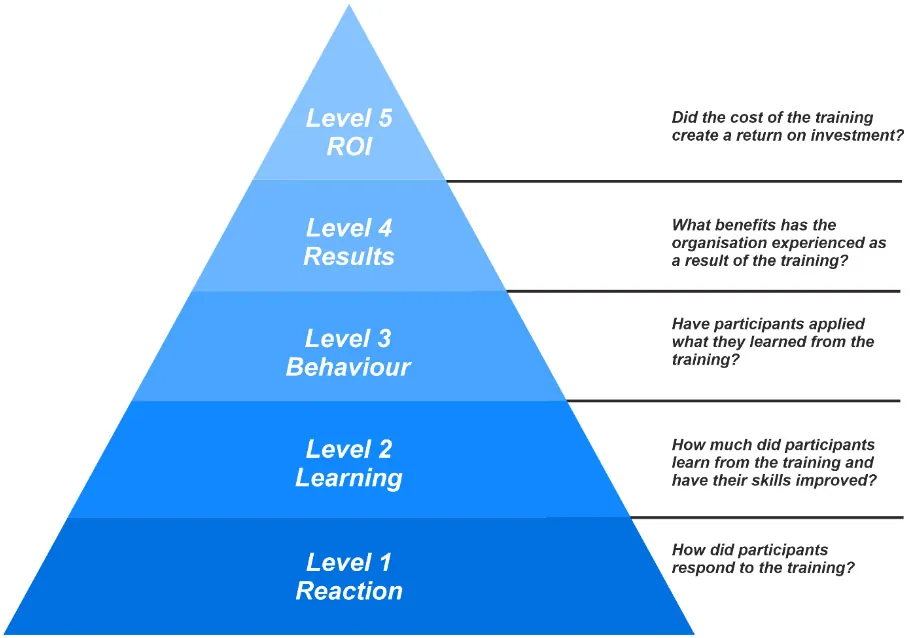
The Phillips model uses an equation to calculate the return on investment of learning and development activities.

The equation is the benefit of the training minus the cost of the training divided by the cost of the training, multiplied by one hundred. That gives you the return on investment as a percentage increase or decrease.
Here’s a quick illustration of this equation:
Imagine that you have just engaged a training provider to deliver a leadership development programme to 40 managers and the total cost of the programme was £45,000.
Your department then interviewed all the managers and gathered hard data from all the resources available to work out what all the benefits were.
Here are some of the benefits that occurred over a 6-month period:
- 5% time-saving in a particular task = £35,000 (40 managers x £17,500 salary for 6 months x 5%)
- 3 contracts renegotiated with a saving of £20,000 due to techniques covered on the programme
- Normal number of leavers across 40 teams would be 25 staff. Actual number of leavers was 9. (Saved 16 recruitment agency fees of £4,000 per head) = saving of £64,000
Based only on those 3 benefits above we can pop them into the equation.
164% ROI = (Benefit £35k+£20k+£64k – Cost £45k) / Cost £45k
Learning Transfer Evaluation Model (LTEM)
The LTEM model was inspired by a piece of learning research.
Click on the link above for a one-page overview of the model and here’s a report on the findings.
The Kaufman Model
This model is a little like Phillips in that it adds a fifth level to the Kirkpatrick model. The Kaufman model is all about evaluating and measuring the impact and effectiveness of training on different groups.
The Anderson Model
Known as the Value of Learning model, it focuses more on the effectiveness and evaluation of an organisation’s learning strategy rather than the evaluation of learner effectiveness. It’s more about aligning an organisation’s learning strategy with their overall business strategy.
The Brinkerhoff Model
This model focuses on comparing the successes of a learning event to its “failures”, it looks at successful case studies and examples from the training and compares them to the least effective. All this feeds into recommendations of what to do and what not to do in the future to sustain success. It’s referred to as the Success Case Method.
The CIRO Model
CIRO stands for context, input, reaction, and output. The way it differs to say, Kirkpatrick, is that it focuses on measuring criteria before and after a learning and development initiative or resource.
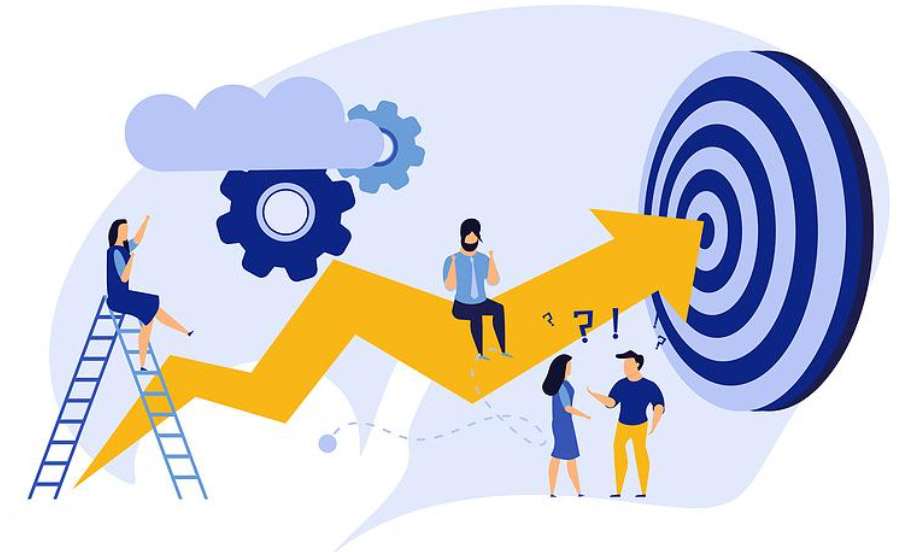
What contributes to positive Learning Transfer?
There are two main things:
- The support and resources available to help implement learning pre and post-learning event
- The relevancy of L&D courses and resources to roles and outcomes
Let’s take a closer look at each one.

Support & sesources for Learning Transfer activities
Here are some activities which will help with the positive transfer of learning.
- Peer-to-peer coaching
- Line manager observation
- Internal mentoring
- Ongoing assessments and quizzes
- Regular refreshers
- Company frees up time for practice
- Ongoing support groups
- Online chat groups
- Social learning
- Regular 360 feedback
- Quarterly surveys of what you have embedded
- Self-assessment
- Goal setting and review
- Ongoing training needs review
- Positive learning culture (this is up to your organisation)
- Practice and modelling
- Lifelong learning promotion
- Career goal alignment
- Job connection links with learning and outcomes

Relevancy of learning resources
Below we’ve compiled fifteen approaches you might incorporate within your training methodology and resources to make them more relevant.
There are many more you might try, but these are among the most popular:
- Keep it real. In all your materials, courses and resources ensure that you include real-life examples that directly relate to daily challenges that your learners face in their roles. One of the most common reasons why learners seem disengaged is that the lessons being taught aren’t felt to be relevant or applicable. In interactive sessions, have learners provide their own examples for the topics under discussion.
- Make it personal. Include examples from your company. This helps build trust and rapport between the learner and the course leader or resource. Personal stories help ground the learning and remove some of the distance between the theory and the practice.
- Ask questions. Make sure you pause to assess how much is being absorbed at various stages of the learning process. Simple questions can be posed to course attendees to gain insight into what’s been understood.
- Answer questions. Make sure you give permission for learners to ask burning questions during live sessions. It’s not enough to permit them to approach you afterwards, since the question may have proven directly pertinent to the topic at hand. By not sharing this moment with the group an opportunity is missed. Ask attendees to raise a hand so you can choose an appropriate moment for interruption. Use the chat facility and hand up facility for virtual training sessions.
- Allow time for reflection. It’s important not to rush through a course or learning resources. Some knowledge will take time to percolate within the minds of your learners. Allow time for these moments to sink in and become personalised.
- Introduce variation. Aim to provide a blended learning approach to cater for different styles and preferences.
- Use mixed media. Engage all the senses of participants by using text, images, video, sound, objects, games, and other means to help embed the learning.
- Continuity. If you have an ongoing programme of modules to deliver then make sure that at the start of each module, some time is set aside to thoroughly review what has been tried back in the workplace. Ask for successes and failures and what extra support is required.
- Make it fun. Anything you can do to instil a bit of fun into the learning experience will help. Even something as simple as a quiz can make learning more enjoyable. Hybrid or eLearning models are especially good for this purpose, since they can leverage all manner of online games and interactivity to gamify the experience.
- Leverage competitiveness. Related to the above point, breaking groups up into team exercises, whether explicitly competitive or not, will help motivate individuals to participate more fully, engage better and remember more of the topic at hand. With an online model, offering the opportunity to retake quizzes, increase performance scores or win badges can be remarkably effective.
- Learn from students. Humble educators are popular ones – allow for gaps in your own knowledge and allow attendees to supply their own teachable moments where appropriate. Get a discussion going and you’ll find participants are already engaging in active learning transfer.
- Practice transference. There may be opportunities to ask learners to recap previous lessons to one another, which helps you monitor how well learning has been imprinted at the same time as instilling learning through practice.
- Use storytelling. Metaphors, fables, and illustrative stories help enrich what could be otherwise dry lessons. Aesop knew this in 560BC when he encoded simple moral lessons in amusing children’s stories, such as the hare and tortoise, whose lesson about arrogance and perseverance lives on to this day. If 2500 years of continuous learning transference doesn’t prove the power of narrative, then what does?
- Assign homework. This may not prove a popular suggestion, but making learners think about and employ some of their new skills whilst they are between sessions can help impress learning. We know that one of the key components of learning transference is repeated practical application, so the more opportunities learners have to test out their skills the better. As ever with such strategies, less is more.
- Read feedback forms. Too often such assessments are obtained in lip service to the notion of improvement. However, if you’ve made it possible for learners to be open and honest, you’ll always get some helpful feedback which will allow for improvement in subsequent sessions and resources. You may choose to do an evaluation midway through a longer programme, as well as one at the end. Always ensure that such forms are submitted anonymously. It doesn’t matter who said what, but it does matter what was said.
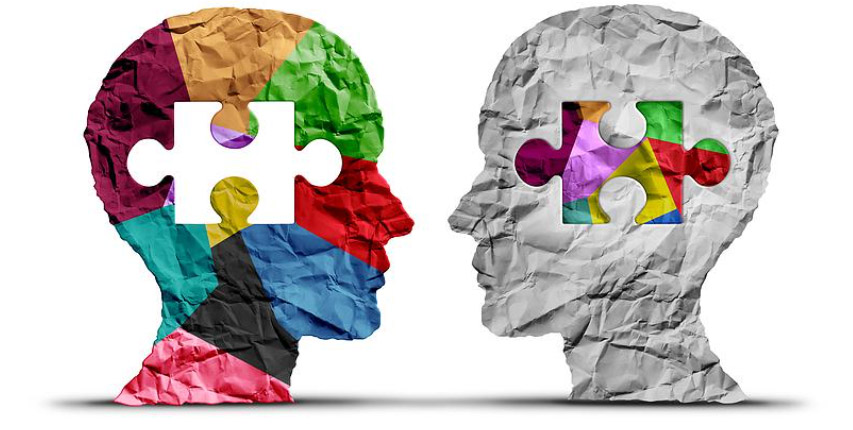
Create a learning culture to help transfer the learning
All these tips are all well and good but if your organisation hinders rather than helps your efforts then you will be facing a losing battle from the start.
The organisations that promote and value learning and development do far better than those who see it as just an expense.
To do this, it’s important that you have a learning culture.
There are measures you can take to help with this, and they will ultimately help to maximize the chances of real learning transfer occurring.
Here are just five suggestions:
1: Create a Culture of Constant Learning
Too often eLearning is just a suite of courses that participants feel obliged to “tick off” so that they can return to their daily work. Instead, if the learning is built around what each employee needs to improve, it will be perceived as more beneficial.
When learning is incorporated as a regular part of employees’ roles, it will not be seen as an irritating adjunct.
To do this, from day one, an organisation needs to express a belief in the value of constant study and improvement. Learning content can include newsletters, webinars and other “refreshers” which focus on practical aspects of employees’ roles, as well as organised programmes.
The important thing is that the process of learning is cyclical, and learners see marked improvements when they use the lessons learned. Here’s where the measurement of learning metrics will benefit both management and employees alike.
2: Incorporate Learning within Development
The completion of training, and the consequent improvement in performance, should be incorporated within appraisals and career progression. This will help promote attendance, engagement, and adherence.
Provide hybrid or eLearning models which can be engaged with at employees’ own speed and dipped into in short bites to ensure that learning fatigue does not set in.
3: Customised Development
Rather than buying in readymade programmes that only tangentially connect with employees’ work, why not devise bespoke learning with practical outcomes?
The flexibility of hybrid programmes is that employers can devise unique combinations of guest speaker webinars, group sessions, online programmes, and exercises which constitute a close fit with regular tasks.
Include a practical project which takes a real piece of work and applies a new skill or approach to it. This helps demonstrate how useful the programme can be.
4: Have Line Managers Follow-Up
Assuming managers are up to speed with course content and resources, they can follow up to ensure that new skills are being used within the workplace. This should be done in a supportive rather than disciplinary mode.
If lessons haven’t been applied, then an opportunity to refresh key skills can be provided. The approach should be encouraging, rather than punitive, with rewards and appreciation given to those who do demonstrate dramatic performance improvement.
5: Socialise Your Learning
Online forums or Slack channels can be useful. Learners can share the skills they have developed, ask questions, and offer feedback. This can be particularly helpful where the programme has been presented largely online, since it builds a group dynamic.
Such forums also leverage a bit of competition, with participants wanting to outdo one another in terms of performance improvement.
Positive Learning Transfer should be the goal
As we’ve seen in this article, when learning can be transferred, this means it has been fully internalised and absorbed by each learner, then applied in practice.
There are ways of measuring learning transference and allowing for your L&D efforts to be better aligned both with corporate strategy and individual employee priorities.
Workplaces need to design their suite of learning and development activities for maximum practical applicability. Ideally, everything that you do should be built with minimal gaps between learning sessions and the direct application of newly gained skills.
By following the approaches outlined above, you give your L&D initiatives the best chance to have a wide-ranging impact which is strategically aligned with corporate goals, and which participants take part in enthusiastically which ultimately leads to better business outcomes and performance.
As an eLearning company, Skillshub is committed to creating efficient and impactful learning experiences.
Contact Skillshub to discuss any of your eLearning platform requirements. A platform can help you to embed the learning by delivering learning in the moment of need.








